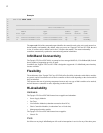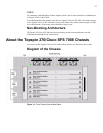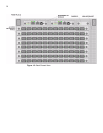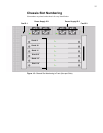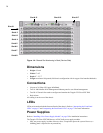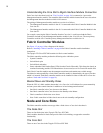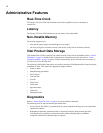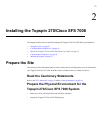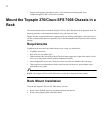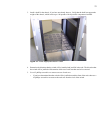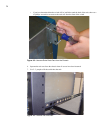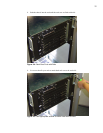18
Understanding the Core Slot to Mgmt Interface Module Connection
Each Core slot in the chassis (refer to “The Core Slot” on page 18) is connected to 1 port on the
Management Interface module. The controller (fabric interface module inserted in the core slot) selects
the Management Interface module to which it will connect.
The pairing of Management Interface module to core slot is as follows:
• The Management Interface module in slot #15 is connected to the Fabric Controller Module in the
Core slot #11.
• The Management Interface module in slot #16 is connected to the Fabric Controller Module in the
Core slot #12.
For example, removing the Fabric Controller from the Core slot 11 would cause both the Fabric
Controller card and its paired Management Interface module in slot 15 to fail-over. The new primary
Controller would be slot 12 and the primary Management Interface would be slot 16.
Fabric Controller Modules
See Figure 1-2 on page 14 for a diagram of the chassis.
Refer to “Installing a Fabric Controller” on page 44 for Fabric Controller module installation
instructions.
The Topspin 270/Cisco SFS 7008 contains six fabric control modules.
The fabric controller modules perform the following roles within the system:
• System Controller
• Switch fabric spine
• Switch fabric end-nodes
• Stores redundant Vital Product Data (VPD) from the Chassis ID module. This allows the chassis to
continue functioning (and the VPD information to be recovered) even if a Chassis ID module fails.
Each Fabric Controller module runs the management software and contains non-volatile storage.
The behavior and responsibility of each fabric controller module is determined by the type of slot into
which it is inserted. Each fabric controller module can be installed in either a Node slot or a Core slot
(refer to “Node and Core Slots” on page 18).
Master/Slave and Standby Roles
When the CPU of a fabric module detects that is in a Core slot, it will arbitrate for system mastership
and run system wide control functions in addition to its local management functions.
• One fabric controller in the Core slot acts as the Master
• One fabric controller in the Core slot acts as the Standby to the Master
• Fabric controllers in Node slots act as slaves
• Note: Fabric controllers in Node slots do not act in active/standby configuration
Node and Core Slots
The fabric controller modules can occupy either a Node slot or a Core slot in the chassis.
The Node Slot
There are four Node slots in the Topspin 270/Cisco SFS 7008.
Fabric modules installed in Node slots provide fabric leaf switching, as opposed to controller
functionality.
The Core Slot
There are two Core slots in the Topspin 270/Cisco SFS 7008.





